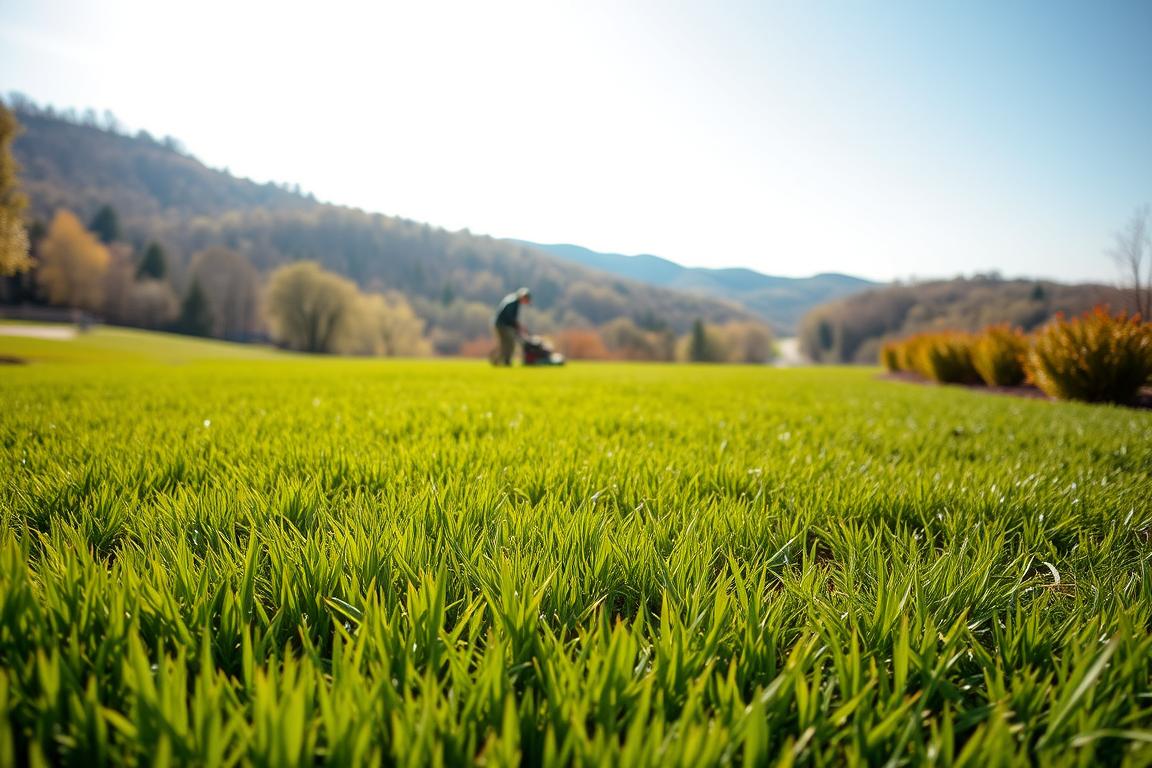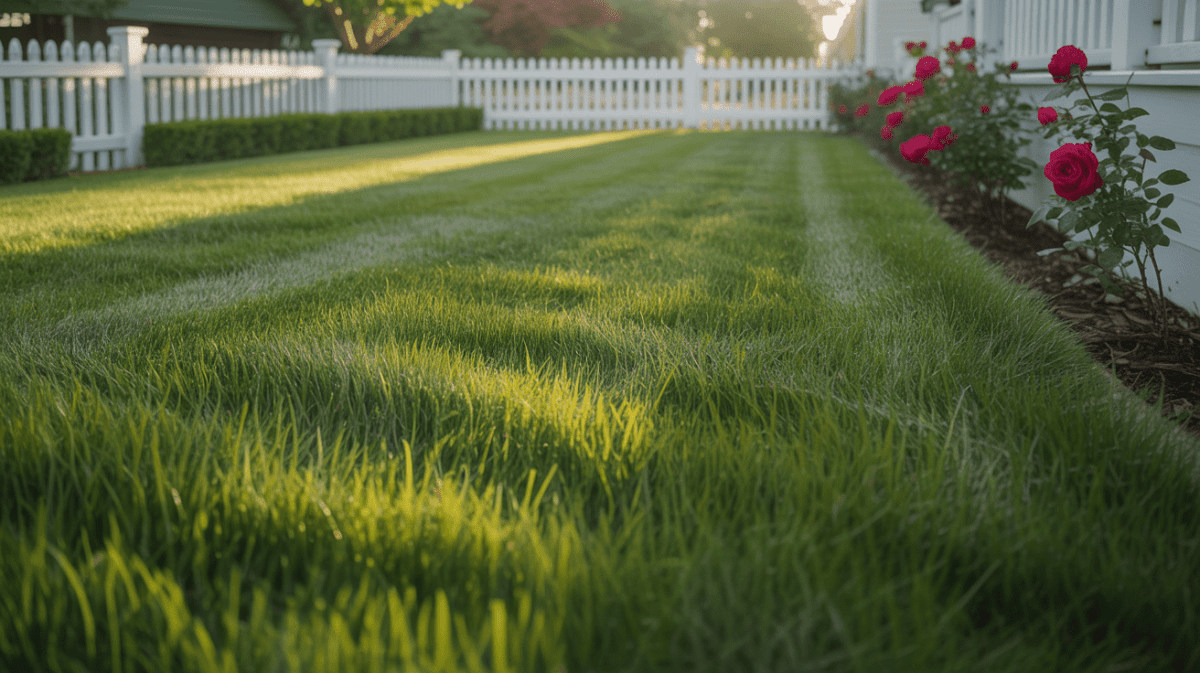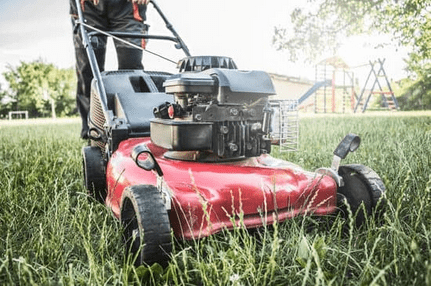Kentucky Bluegrass: A Vibrant Natural Wonder

Kentucky Bluegrass is loved for its lush look. It has fine blades and a blue-green color, making it a timeless favorite.
This grass is not just pretty; it's also deeply rooted in culture. In the Bluegrass region, it's a symbol of identity and heritage.
With the right lawn care tips, Kentucky Bluegrass can flourish. It's the best grass for lawns in many areas.
Key Takeaways
- Bluegrass seed varieties offer diverse options for lawn landscaping.
- Proper lawn care is essential for maintaining healthy Kentucky Bluegrass.
- Kentucky Bluegrass is renowned for its vibrant, lush appearance.
- It's a popular choice for lawns due to its aesthetic appeal.
- Landscaping with bluegrass can enhance the beauty of outdoor spaces.
What Makes Kentucky Bluegrass Special
Kentucky Bluegrass is known for its ability to fix itself and grow well in different conditions. Its lush look makes it a favorite among homeowners and landscapers.
Distinctive Characteristics of Poa Pratensis
Kentucky Bluegrass, or Poa Pratensis, is a cool-season grass with a dark green color and fine texture. It's special because it forms a dense sod. This sod can repair itself through tillering, where new shoots grow from the plant's crown.
This self-repairing capability is a big plus. It helps the grass recover from wear and tear. This makes it perfect for lawns that get a lot of use.
Popular Kentucky Bluegrass Varieties
There are many varieties of Kentucky Bluegrass, each with its own special traits. Some of the most popular ones are:
- ‘Midnight’: Known for its dark green color and fine texture.
- ‘Kenblue’: Offers a good balance between shade tolerance and drought resistance.
- ‘Baron’: Recognized for its vigorous growth and good disease resistance.
| Variety | Shade Tolerance | Drought Resistance | Disease Resistance |
|---|---|---|---|
| ‘Midnight’ | Moderate | Low | High |
| ‘Kenblue’ | High | Moderate | Moderate |
| ‘Baron’ | Low | High | High |
Ideal Growing Conditions
Kentucky Bluegrass loves cool climates with moderate temperatures and enough moisture. It grows best in well-drained soil with a pH between 6.0 and 7.0. It can handle some shade but does best in full sun to partial shade.
To grow well, Kentucky Bluegrass needs regular care. This includes mowing, watering, and fertilizing. With the right care, the lawn stays healthy and vibrant all season.
Caring for Your Kentucky Bluegrass Lawn

To keep your Kentucky Bluegrass lawn healthy and vibrant, it's essential to understand the basics of its care. Proper maintenance not only enhances the aesthetic appeal of your lawn but also contributes to its durability and resilience against environmental stresses.
Planting and Establishment Tips
When planting Kentucky Bluegrass, it's crucial to start with proper soil preparation. This involves testing your soil type and pH level, then amending it if necessary to ensure it's slightly acidic to neutral (pH 6.0-7.0). Sod installation is a popular method for establishing a new lawn, as it provides immediate results and can be more reliable than seeding.
For successful establishment, maintain consistent moisture during the first few weeks after planting. This may involve regular watering, especially during dry spells. It's also beneficial to apply a starter fertilizer to promote root development.
Seasonal Maintenance Guide
Spring and Summer Care
During spring and summer, your Kentucky Bluegrass lawn requires regular mowing and watering. Maintain your mower at a height of 2.5-3 inches to promote deep root growth. Water deeply but infrequently to encourage the lawn to grow deeper roots, making it more drought-resistant.
Fertilization is also key during this period. Apply a lawn fertilizer for bluegrass in late spring to promote healthy growth and color. Be cautious not to over-fertilize, as this can lead to excessive growth that requires more frequent mowing.
Fall and Winter Preparation
As fall approaches, continue to mow your lawn regularly, but you can gradually raise the mowing height to 3-3.5 inches. Apply a fall fertilizer that is high in phosphorus to promote root growth and prepare your lawn for the next growing season.
In winter, Kentucky Bluegrass lawns are dormant, but they still require some care. Avoid walking on frozen or snow-covered grass, as this can damage the blades and compact the soil.
Troubleshooting Common Issues
Common issues with Kentucky Bluegrass lawns include weed invasion, disease, and pest damage. Regularly inspect your lawn for signs of trouble, and take action promptly when necessary. For weeds, consider using a selective herbicide. For diseases and pests, cultural practices such as proper mowing and watering can help prevent many issues.
- Maintain good air circulation to prevent disease.
- Use appropriate pest control measures when necessary.
- Overseed bare spots to maintain lawn density.
Conclusion
Kentucky Bluegrass is loved for its beauty and toughness. It's a top pick for both homeowners and landscapers. When picking a grass type, it's key to compare Kentucky Bluegrass with others like Tall Fescue.
Kentucky Bluegrass has a finer texture and brighter color than Tall Fescue. This makes it great for landscaping. But, it needs more care, like regular mowing and watering, to stay healthy.
To get the most out of Kentucky Bluegrass, follow some important tips. Keep your lawn mowed and watered consistently. Also, fertilize it regularly. This will help your lawn look lush and green.
In the end, Kentucky Bluegrass is a great choice for a beautiful and lasting lawn. With the right care, it can make your outdoor space even better. It also boosts your property's value over time.
FAQ
What is Kentucky Bluegrass?
Kentucky Bluegrass, also known as Poa Pratensis, is a cool-season grass. It has fine blades and a lush blue-green color. This makes it a favorite for lawns.
What are the benefits of Kentucky Bluegrass?
Kentucky Bluegrass is great for lawns. It can fix itself, looks beautiful, and does well in cool weather. It's also good for lawns with some foot traffic.
How do I care for my Kentucky Bluegrass lawn?
To care for your lawn, start with good soil. Water it regularly and fertilize at the right times. Mowing it often keeps it healthy and looking good.
What are the ideal growing conditions for Kentucky Bluegrass?
Kentucky Bluegrass loves cool weather and enough moisture. It grows best in well-draining soil that's slightly acidic to neutral.
How do I plant Kentucky Bluegrass?
First, loosen your soil to 8-10 inches deep. Then, sow seeds or lay sod. Keep the soil moist during the first few weeks.
What are some common issues with Kentucky Bluegrass lawns?
Lawns can face drought, disease, and pests. Regular care, like watering and fertilizing, helps avoid these problems.
How does Kentucky Bluegrass compare to other grass varieties?
Kentucky Bluegrass is a cool-season grass known for its dark green color and fine texture. It's easy to care for and does well in many conditions.
Can I grow Kentucky Bluegrass in warm climates?
Kentucky Bluegrass may not do well in warm climates. It prefers cooler temperatures and enough moisture.
How often should I fertilize my Kentucky Bluegrass lawn?
Fertilizing frequency depends on your lawn's needs. Usually, Kentucky Bluegrass lawns need it in spring and fall.



